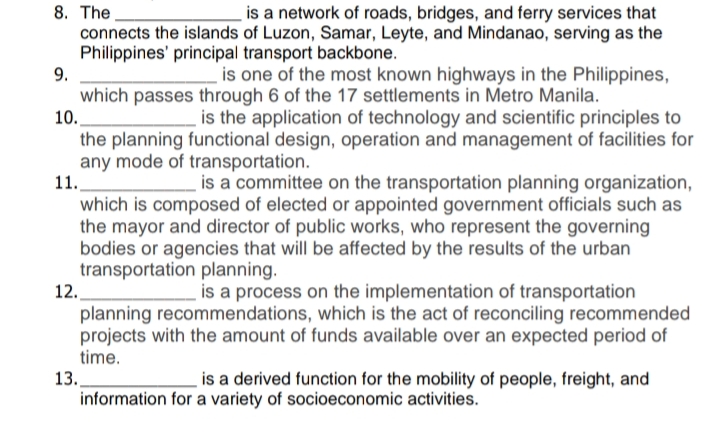is a network of roads, bridges, and ferry services that 8. The connects the islands of Luzon, Samar, Leyte, and Mindanao, serving as the Philippines' principal transport backbone. 9. is one of the most known highways in the Philippines, which passes through 6 of the 17 settlements in Metro Manila. 10. is the application of technology and scientific principles to the planning functional design, operation and management of facilities for any mode of transportation. 11. is a committee on the transportation planning organization, which is composed of elected or appointed government officials such as the mayor and director of public works, who represent the governing bodies or agencies that will be affected by the results of the urban transportation planning. 12. is a process on the implementation of transportation planning recommendations, which is the act of reconciling recommended projects with the amount of funds available over an expected period of time. 13. information for a variety of socioeconomic activities. is a derived function for the mobility of people, freight, and
is a network of roads, bridges, and ferry services that 8. The connects the islands of Luzon, Samar, Leyte, and Mindanao, serving as the Philippines' principal transport backbone. 9. is one of the most known highways in the Philippines, which passes through 6 of the 17 settlements in Metro Manila. 10. is the application of technology and scientific principles to the planning functional design, operation and management of facilities for any mode of transportation. 11. is a committee on the transportation planning organization, which is composed of elected or appointed government officials such as the mayor and director of public works, who represent the governing bodies or agencies that will be affected by the results of the urban transportation planning. 12. is a process on the implementation of transportation planning recommendations, which is the act of reconciling recommended projects with the amount of funds available over an expected period of time. 13. information for a variety of socioeconomic activities. is a derived function for the mobility of people, freight, and
Traffic and Highway Engineering
5th Edition
ISBN:9781305156241
Author:Garber, Nicholas J.
Publisher:Garber, Nicholas J.
Chapter11: The Transportation Planning Process
Section: Chapter Questions
Problem 9P
Related questions
Question

Transcribed Image Text:8. The.
connects the islands of Luzon, Samar, Leyte, and Mindanao, serving as the
Philippines' principal transport backbone.
9.
is a network of roads, bridges, and ferry services that
is one of the most known highways in the Philippines,
which passes through 6 of the 17 settlements in Metro Manila.
10.
is the application of technology and scientific principles to
the planning functional design, operation and management of facilities for
any mode of transportation.
11.
is a committee on the transportation planning organization,
which is composed of elected or appointed government officials such as
the mayor and director of public works, who represent the governing
bodies or agencies that will be affected by the results of the urban
transportation planning.
12.
is a process on the implementation of transportation
planning recommendations, which is the act of reconciling recommended
projects with the amount of funds available over an expected period of
time.
13.
is a derived function for the mobility of people, freight, and
information for a variety of socioeconomic activities.

Transcribed Image Text:4.
entry or exit points in a transport system.
5. These are composed of a set of linkages expressing the connectivity between
places and the capacity to handle passenger and cargo volumes is called
are where the movements are originating, ending, and transiting,
6.
physical reality of a network and are designed to handle demand with specific
volume and frequency characteristics.
7.
networks, and the demand.
are the conveyances such as roads and terminals expressing the
can be conceptualized as the set of relationships between nodes,
Expert Solution
This question has been solved!
Explore an expertly crafted, step-by-step solution for a thorough understanding of key concepts.
Step by step
Solved in 2 steps

Knowledge Booster
Learn more about
Need a deep-dive on the concept behind this application? Look no further. Learn more about this topic, civil-engineering and related others by exploring similar questions and additional content below.Recommended textbooks for you

Traffic and Highway Engineering
Civil Engineering
ISBN:
9781305156241
Author:
Garber, Nicholas J.
Publisher:
Cengage Learning

Engineering Fundamentals: An Introduction to Engi…
Civil Engineering
ISBN:
9781305084766
Author:
Saeed Moaveni
Publisher:
Cengage Learning

Traffic and Highway Engineering
Civil Engineering
ISBN:
9781305156241
Author:
Garber, Nicholas J.
Publisher:
Cengage Learning

Engineering Fundamentals: An Introduction to Engi…
Civil Engineering
ISBN:
9781305084766
Author:
Saeed Moaveni
Publisher:
Cengage Learning